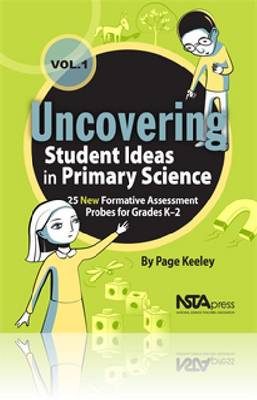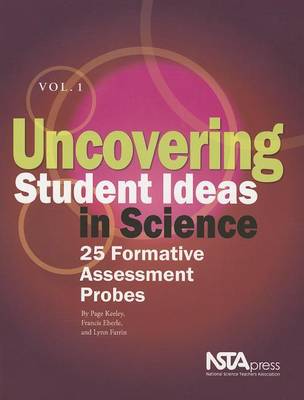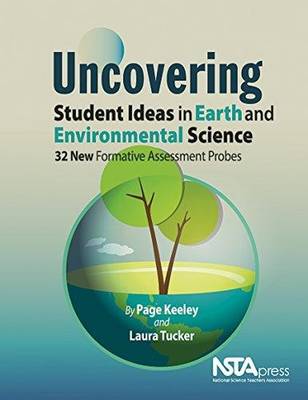Uncovering Student Ideas in Science
3 total works
What ideas do young children bring to their science learning, and how does their thinking change as they engage in "science talk"? Find out using the 25 field-tested probes in the newest volume of Page Keeley's bestselling Uncovering Student Ideas in Science series, the first targeted to grades K-2.
This teacher-friendly book is:
Tailored to your needs. The content is geared specifically for the primary grades, with an emphasis on simple vocabulary as well as drawing and speaking (instead of writing). The format of the student pages uses minimal text and includes visual representations of familiar objects, phenomena, or ideas.
Focused on making your lessons more effective. The assessment probes engage youngsters and encourage "science talk" while letting you identify students' preconceptions before beginning a lesson or monitor their progress as they develop new scientific explanations.
Applicable to a range of science concepts. This volume offers 8 life science probes, 11 physical science probes, and 6 Earth and space science probes that target K-2 disciplinary core ideas.
Ready to use. The book provides grade-appropriate reproducible pages for your students and detailed teacher notes for you, including clear and concise explanations, relevant research, suggestions for instruction, and connections to national standards.
Uncovering Student Ideas in Primary Science is an invaluable resource for classroom and preservice teachers and professional development providers. This age-appropriate book will help you teach more effectively by starting with students' ideas and adapting instruction to support conceptual change.
This teacher-friendly book is:
Tailored to your needs. The content is geared specifically for the primary grades, with an emphasis on simple vocabulary as well as drawing and speaking (instead of writing). The format of the student pages uses minimal text and includes visual representations of familiar objects, phenomena, or ideas.
Focused on making your lessons more effective. The assessment probes engage youngsters and encourage "science talk" while letting you identify students' preconceptions before beginning a lesson or monitor their progress as they develop new scientific explanations.
Applicable to a range of science concepts. This volume offers 8 life science probes, 11 physical science probes, and 6 Earth and space science probes that target K-2 disciplinary core ideas.
Ready to use. The book provides grade-appropriate reproducible pages for your students and detailed teacher notes for you, including clear and concise explanations, relevant research, suggestions for instruction, and connections to national standards.
Uncovering Student Ideas in Primary Science is an invaluable resource for classroom and preservice teachers and professional development providers. This age-appropriate book will help you teach more effectively by starting with students' ideas and adapting instruction to support conceptual change.
Uncovering Student Ideas in Science, Volume 1
by Page Keeley, Francis Eberle, and Lynn Farrin
Published 30 March 2005
Using probes as diagnostic tools that identify and analyze students’ preconceptions, teachers can easily move students from where they are in their current thinking to where they need to be to achieve scientific understanding.
If you’re new to formative assessment probes, you’ll love the latest book in the bestselling Uncovering Student Ideas in Science series. Authors Page Keeley and Laura Tucker give you 32 engaging questions, or probes, that can reveal what your students already know—or think they know—about core Earth and environmental science concepts. Armed with those insights, you can use the probes’ teacher notes to adjust your approach and present the science in grade-appropriate ways so students will learn the content accurately.
If you’re among the thousands of educators who love the Uncovering Student Ideas in Science series and crave probes specifically about Earth and environmental science, you’re in luck. The probes are organized into four sections: land and water; water cycle, weather, and climate; Earth history, weathering and erosion, and plate tectonics; and natural resources, pollution, and human impact.
The 10th book in this wildly popular, award-winning series offers field-tested teacher materials that provide science background and link to national standards, including the Next Generation Science Standards. The new probes are short, ready to reproduce, and easy to use. Why wait? It’s time to help your students demystify why the ocean is salty, how old the Earth is, and which direction water swirls when it goes down the drain.
If you’re among the thousands of educators who love the Uncovering Student Ideas in Science series and crave probes specifically about Earth and environmental science, you’re in luck. The probes are organized into four sections: land and water; water cycle, weather, and climate; Earth history, weathering and erosion, and plate tectonics; and natural resources, pollution, and human impact.
The 10th book in this wildly popular, award-winning series offers field-tested teacher materials that provide science background and link to national standards, including the Next Generation Science Standards. The new probes are short, ready to reproduce, and easy to use. Why wait? It’s time to help your students demystify why the ocean is salty, how old the Earth is, and which direction water swirls when it goes down the drain.


